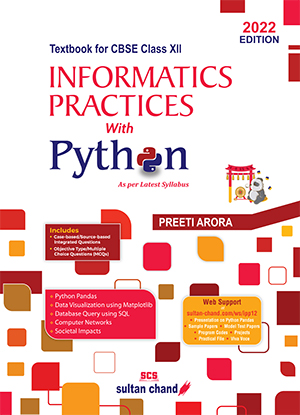
Informatics Practices with Python: Textbook for CBSE Class 12
-
Board: CBSE
-
Class: 12
-
Subject: Informatics Practices
-
Publication Date :
N.A -
ISBN Number :
9384081448 -
Language :
English
Programming is important for learning to innovate and create solutions to global problems. Programming is also important in our day-to-day life to enhance the power of computers and internet. A significant step towards learning innovative programming solutions is through Python programming which this book has at its core. This thoroughly revised book, Informatics Practices with Python (065), for Class XII fully meets the latest syllabus requirements and strictly adheres to the guidelines laid down by the CBSE. The book deals with detailed concepts of Python Pandas, Data Visualization, Computer Networks, Relational Database Management System (SQL) and Societal Impacts. Python is a popular Object-Oriented Programming language used both for standalone programs and scripting applications in a variety of domains. This book adopts a contemporary approach to the most popular Python library, Pandas, with emphasis on principles of effective and good programming, such as clarity, legibility and efficiency in program design. Thus, an interactive programming style has been emphasized and expressed throughout the book. The hallmark of this book is that it teaches Python Pandas concepts in detail as well as usage of several other Python libraries, such as plotting graphs and charts using Matplotlib. Ample case studies to understand the basic concepts of Computer Networks with a student-centred approach have also been provided in the book. With easy-to-understand examples, practical implementations and other tools, students will learn how to create and implement Python Series and Dataframes and perform data manipulation and analysis using advanced associated operations. The text of the book has been presented in a friendly and easy-to-comprehend language. The book contains example programs that are concise and practical besides diagrams and examples from real-life applications. Each chapter provides tested, debugged and error-free codes with screenshots. Based on the CBSE curriculum, the book has been divided into four units: Unit I: Data Handling using Pandas and Data Visualization – Chapters 1 to 3 This unit contains three chapters covering fundamentals of Pandas including Series and Dataframes. Advanced concepts of Pandas such as Pivoting, Sorting, Aggregation, Function Applications, Reindexing and Quantiles have been explained in detail with ample examples and associated codes. Apart from the above, detailed concepts of Data Visualization using Matplotlib in terms of Line Chart, Bar Chart, Pie Chart, Scatter Plot, Histograms, Frequency Polygons and Boxplot have also been thoroughly discussed. Unit II: Database Query using SQL – Chapter 4 This unit covers SQL – its implementation and concepts, Mathematical, String/ Date/Time functions, Aggregate functions along with important SQL clauses such as groupby, having and order by. This unit also covers operations on relations such as Union, Intersection, Minus, Cartesian product and JOIN. PREFACE Unit III: Introduction to Computer Networks – Chapter 5 This unit covers concepts of Computer Networking, types of networks, network devices, network topologies, introduction to internet and its applications, and detailed concepts of a web page, website and web browsers. Unit IV: Societal Impacts – Chapter 6 This unit deals with Digital Footprints, Netiquettes, Intellectual Property Rights, Plagiarism, Licensing, Open Source and Standards, Cybercrime and Cyber Laws, Hacking, Phishing, Cyberbullying along with the Indian IT Act. This unit also includes topics on e-waste management and awareness about health concerns related to the usage of technology. The book has four appendices containing a Sample Project on Dataframe-CSV Connectivity, Viva Voce Questions, Sample Question Paper (Solved) and a Model Test Paper. Apart from these, CBSE Term-I Paper (with Answers) has also been incorporated.
Not yet Available
 Login
Login




